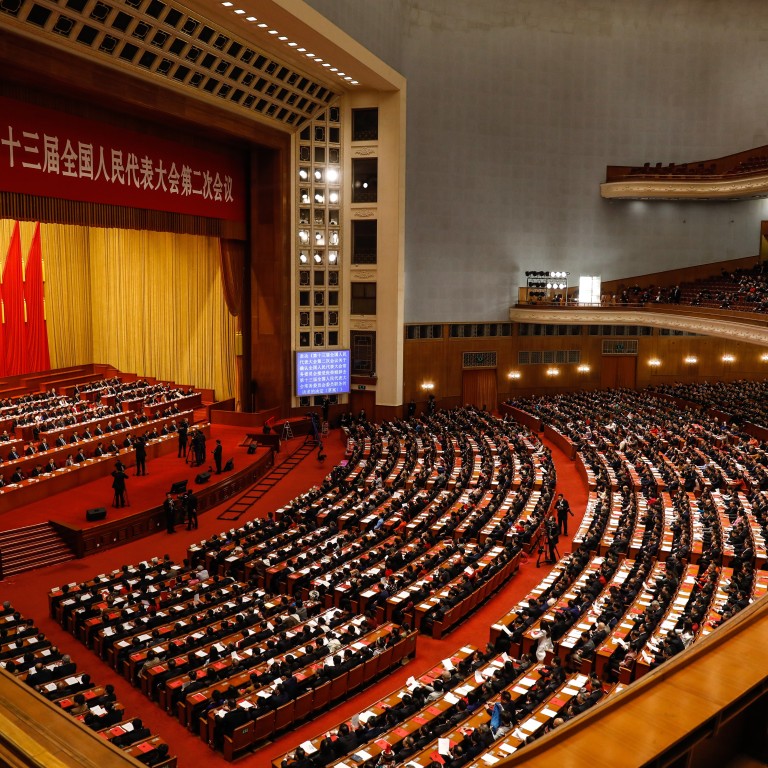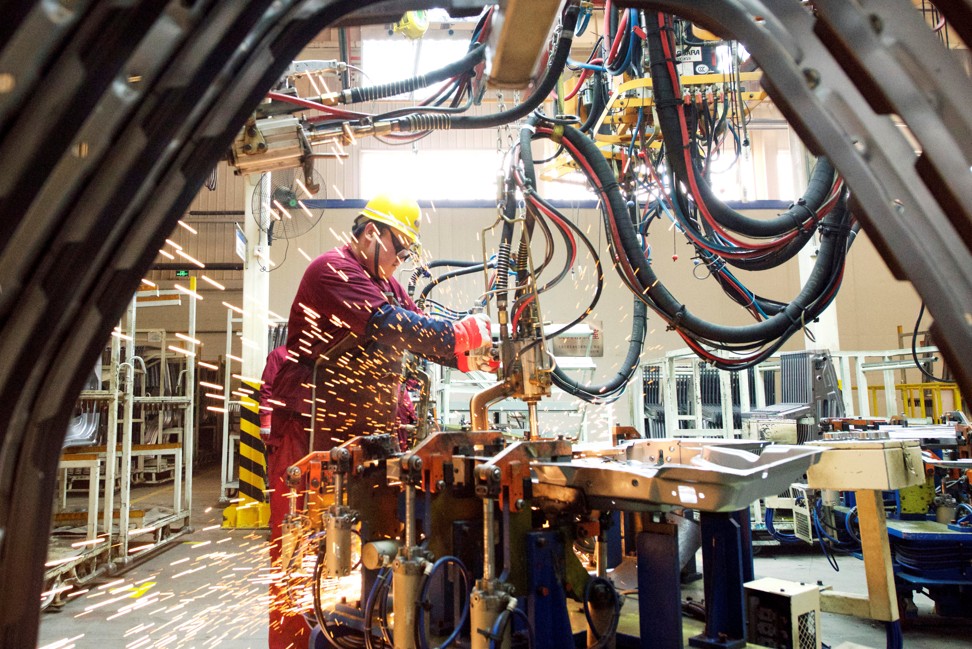
China’s ‘unprecedented and sufficient’ tax cut still does not do enough for small manufacturers, owners say
- Premier Li Keqiang said last week that Beijing will cut the value-added tax (VAT) rate for manufacturing firms by 3 percentage points to 13 per cent from April 1
- Owners play down suggestions it could boost domestic business and aid employment to help offset the slowdown in growth caused by the US-China trade war
After much consideration, Guangdong garment factory owner Steve Liu reluctantly decided to turn down an order from an overseas client for two million pairs of trousers even after China’s decision to cut taxes to help businesses, highlighting the “cruel world” of small and medium-sized manufacturing.
The order of cropped pants would have, in the end, resulted in a loss for Liu as the offer of US$4 (26.86 yuan) per pair was below the 29.3 yuan production cost before tax.
“Those boasting that these policy tax cuts are unprecedented and sufficient, I bet they have never been a boss of a small factory like ours,” he said.
Liu’s decision highlights the dilemma faced by many small and medium-sized (SMEs) manufacturing operations in China as the government’s well-intended efforts to help are not sufficient because of rising costs.
“Do you know why we still prefer the export orders? Because there is no profit at all from the production process. What we earn is the export tax rebate of between 11 and 13 per cent. It’s an open secret in the industry,” added Liu.
“I hesitated for days but had to reject the order. Firstly, I don’t have enough liquidity [because of lack of credit]. Secondly, I have to employ more workers if I take this order.”
“The [value added] tax and [social security contribution] fee reductions are definitely positive and important steps. However, I think, the biggest problems that the Chinese manufacturing sector currently faces is downward pressure on the economy and the severe decline in market demand,” said Yang Senping, a professor at the School of Economics and Business Administration of Jinan University and a member of Guangdong province’s Chinese People’s Political Consultative Conference.
“When the economic situation is good, strong market demand allow manufacturing firms to absorb the pressure from the tax burden. But when the economic situation is very bad, even if the tax reduction is comprehensive, companies do not dare to expand or employ [more] people.
“In addition, most small and medium-sized enterprises are in the middle and upper portions of industrial supply chains. They are facing additional problems of recruiting workers, financing difficulties and a deteriorating local business environment making their survival even more difficult.”
“Those boasting that these policy tax cuts are unprecedented and sufficient, I bet they have never been a boss of a small factory like ours.
Guangdong garment factory owner Liu suggested low margins and weak demand mean that small manufacturers could be forced to fraudulently report their taxes, making a lower tax rate irrelevant.
“If an enterprise has always been law-abiding, the tax cuts could help save a small part of its costs. But if it is not, the policy will not help much, and most SMEs are not, especially in the fields of traditional manufacturing, like textiles and garments,” Liu added.
“The gross profit of an ordinary garment factory is only a few percentage points. Value-added taxes account for between 10 and 20 per cent of the operating costs of a small or medium-sized garment factory, along with other categories of taxes and social contributions. If we don’t attempt reasonable tax avoidance to give the appearance of business losses, most garment factories would just shut down immediately.”
The average after-tax profit margin of Chinese enterprises is 3.3 per cent, while the profit margin of private domestic companies stands at 3.9 per cent, much higher than 2.2 per cent for state-owned enterprises and the 2.1 per cent for foreign-invested companies, according to a 2017 study based on data from the China Enterprise-Employee Survey.
“For those enterprises with annual output valued at more than 50 million [yuan], the VAT tax cuts should have certain economic value, but for us, a small-sized enterprise producing grain and oil processing equipment, it helps little,” said Alice Zhou, who runs a grain and oil processing equipment company in Hunan province.
“For example, our business partner, a grain machine equipment manufacturing enterprise in Zhejiang province, had production valued at 60 million [yuan] in 2018. The company had to pay taxes of six million last year. If the VAT tax rate is reduced to 13 per cent, it means a tax cut of about one million yuan for the company.
“But for my enterprise, our tax rate was originally 13 per cent. Recently, after we registered as a small and micro business, the tax rate dropped to 3 per cent. That is to say, the tax rate is a guaranteed minimum requirement. No matter how much business we do and how low the profit will be, we have to pay 300,000 yuan (US$44,670) in tax for every 10 million yuan (US$1.49 million) of production value.”
At present, the VAT on manufacturing is usually between about 5 and 10 per cent of the total cost which is considered large for the manufacturing industry due to low profit margins, Zhou added.
For hi-tech manufacturing start-ups, the tax cuts are not expected to have much of an impact because the industry already pays low rates due to government incentives.
“The value-added tax cut will have little impact on the biotechnology industry because, under China’s current industrial policy, hi-tech industries, such as biotech companies like ours, have generally enjoyed national tax benefits,” said Cao Lihui, general manager of Yoyoung Biotech, a Guangzhou-based company that develops and produces medical devices and accessories to test for diseases in animals.
“For our company’s products, the value-added tax is already only 3 per cent, and the hi-tech enterprise income tax is 15 per cent, so [the latest tax cut] does not affect or benefit our product pricing and budget.”
But even the hi-tech companies that pay higher tax rates said the planed VAT cut would do little to stimulate production or jobs due to the existing high costs associated with the industry.

“According to what I understand, the tax cuts could help save a few hundred thousand yuan a year,” said Huang Bufu, founder of eSight Technology, which focuses on vision development for industrial automation, such robots for smartphone and shoe manufacturers. The company runs its research and development (R&D) in Hong Kong and Shenzhen, and has a manufacturing plant in Dongguan.
Huang added that manufacturing costs account for about 20 and 30 per cent of the total operational costs of similar tech start-ups.
“Labour costs, especially payments for R&D talent, account for 60 per cent or more. The cost savings from the tax cut is not even not enough to hire one more Ph.D researcher,” he said.
Huang is also concerned labour costs for hi-tech and internet companies will rise this year as they have to pay their social welfare contributions in full, under a stricter social security payment collection system implemented this year.
For traditional, low-tech manufacturers, the biggest problems remain obtaining financing and maintaining a stable labour force, Guangdong garment factory owner Liu said, with the VAT cut “simply a drop in the bucket.”
“The banks and local governments don’t like private SMEs. Although the central government says it wants to support [better access to financing for] small and medium-sized enterprises, but it is difficult to implement. If banks poured money into SMEs, they would not be profitable. And what the banks actually want is only risk control and profits.” Liu said.

